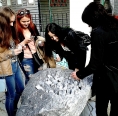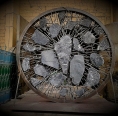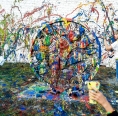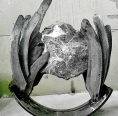-
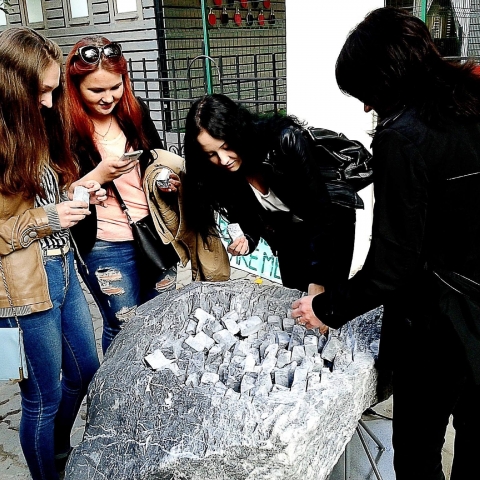
To the Last Stone
-
Address:
Satka
-
Partners:
Jacopo Mandich
For the 3rd Ural Industrial Biennale
As a sculptor, Jacopo Mandich loves the material itself. Meaning that he can see what you don’t expect in the material. Isn’t that the duty of the artist: to discover to us what we don’t see and to show the reality on the other side of the material?
Being a rather young artist, Jacopo Mandich have been noticed in the national and international context for many years already. Due to his natural talent and consistency of technique and style, he managed to conquer the art scene and gain sympathy of many gallery dealers and collectors.
First, I met his works, and getting interested in them, wanted to meet the author. I remember, when I entered his outdoors studio for the first time, I was struck by the creative chaos in the premises filled in with iron, tools, scattered material, either not yet touched, rough-hewn or in the works – the place to look for beauty at! And still, Jacopo manages to extract real fine-grain treasures from this bulk of materials. His works are born from meetings of different materials: iron, wood, stone, minerals – to form a new reality.
For Biennale, Jacopo presents his work, To the Last Stone, a unit of stone (magnesite and dolomite) in the form of crater that reminds of the open cut, from which it was extracted. About 40 cm of rock were taken out of the center of the unit and put back in the form of more or less equal pieces dug out from the rock. Biennale audience was offered to take these pieces and carry them away.
The artist defines the work as “a piece of Earth crust” and designed it as “a kind of puzzle vice versa”, a game that must become a starting point for reflection of exhaustibility of resources and invitation of the public to share responsibility for the result – crater”. With this game, the artists wants to show “how easily modern western society commits to consumption that results in exhaustion of resources” inviting the spectators to think of this global-scale burning issue, the issue of prudent relation to the environment, the issue of social responsibility and conscious consumption.
The work reconciles two opposite aspects: On the one hand, this is a solid sculpture aimed to exist for a long time, on the other hand, this is a temporary installation that must be destroyed exemplifying ephemeral art, and the object that, while following physical laws of the matter, is not created and is not destroyed, but is constantly changing.
Connections between the opposites find themselves in many works of the artist, where the materials as different as wood, glass, metal are combined as symbols of the Earth Mother – this is how the artists hints, invites to respectful relations between the man and the environment, plants and animals, and to peaceful coexistence of the man and the like.
Jacopo Mandich stay in Russia became productive: he has managed to create four works that remained where they were born: one – for Biennale, the second – in the residence that accepted him, the third one – in the factory and the last one – in Satka’s public square.
Inspired greatly by the factory that produces magnesite in Satka, Jacopo has created the work referring to such archaic form and material as circle and stone, and that puts forward a very up-to-date thesis “against conflicts”. This is an installation that consists of three elements: the sculpture made of stone and metal, the loaded main gun and the metal rocket.
The sculpture is made of dolomite and magnesite units hung inside the metal circle (of two-meters’ diameter) – the symbol of cyclicity. These units bring to mind dynamics of matter fracturing representing tenuity and compaction, the cycle of creation and destruction. The structure is installed in Satka’s public square against the wall; the rocket is on the wall itself, while the main gun is four meters away from the sculpture. And again, the audience was invited to take active part and to shoot pains from the gun; the paints would leave marks on the sculpture, stains on the wall dispersing around the circumference of the sculpture, and among these bright stains there is a symbol rocket that is a starting point for critical thinking of using this industrial material to produce weapon.
It is typical of Jacopo to learn and interpret the spirit of the place: this we see his circle made of wood and metal is presented in the sea front in Ostia (located not far from Rome) – it is created from the raw materials that can quite possibly be found right in the beach, brought by the nearest Tiber River. In Satka he also uses local materials, magnesite and dolomite, wishing to show history of the stone produced with the destructive power of dynamite and – mostly – to present the idea of Big Bang, which gave rise to matter and life, in its development. For him, on the higher interpretation level, stone “is a heavenly body, metaphor of the explosion of emotions, the idea that expands and contracts".
By wanting to paint the grey stone he purportedly launches a counterattack to the city, in which this colour prevails: and this counterattack is the urban art event. This reveals more noble intention of the artist – to leave the comprehensive mark of his stay: not to get restricted with just a static sculpture, but to enter the environment with the overall, dynamic art, to merge with the spectator by offering them to ask the question of the reason to live – through the game.
Thus, the mere act of painting the sculpture, this false purpose must encourage not to stop at the level of the external look of the form, but to search for the truth, no matter how small it is, hidden inside, in order to find the essence of the things, the rocket under the sculpture that hints on the possible way of overcoming the conflict in an ongoing quest for the lost harmony.
The way different materials coexist in works of this sculptor and how he attaches dynamics to the static form is a typical and the most innovative element of creativity of Jacopo Mandich.
Simona Kapodimonte: Simona Kapodimonte is an art historian and curator of exhibitions; she is interested in new languages in the modern art, opens new artistic talents. In the 54th Venetian Biennale she coordinated publication of the catalogue of the Italian pavilion and has important experience of arranging exhibitions in significant museums, such as Scuderie del Quirinale, Galleria Borghese, National Gallery of Antique Art in Rome.
-
26.08 - 26.08
DIARY OF THE THIRD INDUSTRIAL BIENNALE
-
28.11 - 28.11
MY SATKA FESTIVAL WINS THE CONTEST OF CORPORATE VOLUNTEER PROJECTS
-
13.10 - 15.10
COOPERATION WITH VGIBL NAMED AFTER M.I. RUDOMINO

